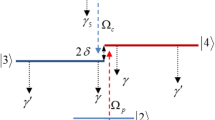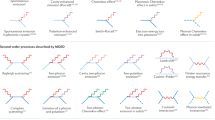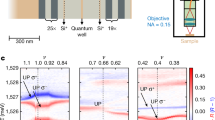Abstract
Subwavelength electromagnetic field localization has been central to photonic research in the last decade, allowing us to enhance sensing capabilities as well as increase the coupling between photons and material excitations. The strong and ultrastrong light–matter coupling regime in the terahertz range using split-ring resonators coupled to magnetoplasmons has been widely investigated, achieving successive world records for the largest light–matter coupling ever achieved. Ever shrinking resonators have allowed us to approach the regime of few-electron strong coupling, in which single-dipole properties can be modified by the vacuum field. Here, we demonstrate, theoretically and experimentally, the existence of a limit to the possibility of arbitrarily increasing electromagnetic confinement in polaritonic systems. Strongly subwavelength fields can excite a continuum of high-momenta propagative magnetoplasmons. This leads to peculiar nonlocal polaritonic effects, as certain polaritonic features disappear and the system enters the regime of discrete-to-continuum strong coupling.
This is a preview of subscription content, access via your institution
Access options
Access Nature and 54 other Nature Portfolio journals
Get Nature+, our best-value online-access subscription
$29.99 / 30 days
cancel any time
Subscribe to this journal
Receive 12 print issues and online access
$209.00 per year
only $17.42 per issue
Buy this article
- Purchase on Springer Link
- Instant access to full article PDF
Prices may be subject to local taxes which are calculated during checkout




Similar content being viewed by others
Data availability
The numerical simulation and measurement data that support the plots within this paper are available from the corresponding author upon reasonable request. Data that support the findings of this Article are also available in the ETH Research Collection43.
Code availability
The codes used in the theory part of this study are available from the corresponding author upon reasonable request.
References
Khurgin, J. et al. Landau damping and limit to field confinement and enhancement in plasmonic dimers. ACS Photonics 4, 2871–2880 (2017).
Stanley, R. Plasmonics in the mid-infrared. Nat. Photon. 6, 409–411 (2012).
Taliercio, T. & Biagioni, P. Semiconductor infrared plasmonics. Nanophotonics 8, 949–990 (2019).
Zhang, X. et al. Terahertz surface plasmonic waves: a review. Adv. Photon. 2, 014001 (2020).
Fei, Z. et al. Gate-tuning of graphene plasmons revealed by infrared nano-imaging. Nature 487, 82–85 (2012).
Forn-Díaz, P. et al. Ultrastrong coupling regimes of light–matter interaction. Rev. Mod. Phys. 91, 025005 (2019).
Frisk Kockum, A. et al. Ultrastrong coupling between light and matter. Nat. Rev. Phys. 1, 19–40 (2019).
Ciuti, C., Bastard, G. & Carusotto, I. Quantum vacuum properties of the intersubband cavity polariton field. Phys. Rev. B 72, 115303 (2005).
Nataf, P. & Ciuti, C. No-go theorem for superradiant quantum phase transitions in cavity QED and counter-example in circuit QED. Nat. Commun. 1, 72 (2010).
Riek, C. et al. Direct sampling of electric-field vacuum fluctuations. Science 350, 420–423 (2015).
Benea-Chelmus, I.-C. et al. Electric field correlation measurements on the electromagnetic vacuum state. Nature 568, 202–206 (2019).
Anappara, A. A. et al. Signatures of the ultrastrong light–matter coupling regime. Phys. Rev. B 79, 201303 (2009).
Todorov, Y. et al. Ultrastrong light–matter coupling regime with polariton dots. Phys. Rev. Lett. 105, 196402 (2010).
Ballarini, D. & De Liberato, S. Polaritonics: from microcavities to sub-wavelength confinement. Nanophotonics 8, 641–654 (2019).
Keller, J. et al. Few-electron ultrastrong light–matter coupling at 300 GHz with nanogap hybrid LC microcavities. Nano Lett. 17, 7410–7415 (2017).
Jeannin, M. et al. Ultrastrong light–matter coupling in deeply subwavelength THz LC resonators. ACS Photonics 6, 1207–1215 (2019).
Maissen, C. et al. Asymmetry in polariton dispersion as function of light and matter frequencies in the ultrastrong coupling regime. New J. Phys. 19, 043022 (2017).
Chikkaraddy, R. et al. Single-molecule strong coupling at room temperature in plasmonic nanocavities. Nature 535, 127–130 (2016).
Reithmaier, J. P. et al. Strong coupling in a single quantum dot-semiconductor microcavity system. Nature 432, 197–200 (2004).
Todorov, Y. & Sirtori, C. Few-electron ultrastrong light–matter coupling in a quantum LC circuit. Phys. Rev. X 4, 041031 (2014).
Ćwik, J. A. et al. Excitonic spectral features in strongly coupled organic polaritons. Phys. Rev. A 93, 033840 (2016).
Scalari, G. et al. Ultrastrong coupling of the cyclotron transition of a 2D electron gas to a THz metamaterial. Science 335, 1323–1326 (2012).
Paravicini-Bagliani, G. L. et al. Magneto-transport controlled by Landau polariton states. Nat. Phys. 15, 186–190 (2019).
Keller, J. et al. Landau polaritons in highly nonparabolic two-dimensional gases in the ultrastrong coupling regime. Phys. Rev. B 101, 075301 (2020).
Bayer, A. et al. Terahertz light–matter interaction beyond unity coupling strength. Nano Lett. 17, 6340–6344 (2017).
Bagiante, S. et al. Giant electric field enhancement in split ring resonators featuring nanometer-sized gaps. Sci. Rep. 5, 8051 (2015).
Chen, X. et al. Squeezing millimeter waves through a single, nanometer-wide, centimeter-long slit. Sci. Rep. 4, 6722 (2014).
Bahk, Y.-M. et al. Ultimate terahertz field enhancement of single nanoslits. Phys. Rev. B 95, 075424 (2017).
De Liberato, S. Virtual photons in the ground state of a dissipative system. Nat. Commun. 8, 1465 (2017).
Forn-Díaz, P. et al. Ultrastrong coupling of a single artificial atom to an electromagnetic continuum in the nonperturbative regime. Nat. Phys. 13, 39–43 (2017).
Cortese, E. et al. Strong coupling of ionizing transitions. Optica 6, 354–361 (2019).
Cortese, E. et al. Excitons bound by photon exchange. Nat. Phys 17, 31–35 (2021).
Ciracì, C. et al. Probing the ultimate limits of plasmonic enhancement. Science 337, 1072–1074 (2012).
Gubbin, C. R. & De Liberato, S. Optical nonlocality in polar dielectrics. Phys. Rev. X 10, 021027 (2020).
Maissen, C. et al. Ultrastrong coupling in the near field of complementary split-ring resonators. Phys. Rev. B 90, 205309 (2014).
Hagenmüller, D., De Liberato, S. & Ciuti, C. Ultrastrong coupling between a cavity resonator and the cyclotron transition of a two-dimensional electron gas in the case of an integer filling factor. Phys. Rev. B 81, 235303 (2010).
Gubbin, C. R., Maier, S. A. & De Liberato, S. Real-space Hopfield diagonalization of inhomogeneous dispersive media. Phys. Rev. B 94, 205301 (2016).
Batke, E., Heitmann, D. & Tu, C. W. Plasmon and magnetoplasmon excitation in two-dimensional electron space-charge layers on GaAs. Phys. Rev. B 34, 6951–6960 (1986).
Jin, D. et al. Topological magnetoplasmon. Nat. Commun. 7, 13486 (2016).
Khurgin, J. B. Ultimate limit of field confinement by surface plasmon polaritons. Faraday Discuss. 178, 109–122 (2015).
Kohn, W. Cyclotron resonance and de Haas–van Alphen oscillations of an interacting electron gas. Phys. Rev. 123, 1242–1244 (1961).
Batke, E., Heitmann, D. & Kotthaus, J. P. Non-locality in the two-dimensional plasmon dispersion. Phys. Rev. Lett. 54, 2367–2370 (1985).
Scalari, G. 2021. ETH Research Collection https://www.research-collection.ethz.ch/handle/20.500.11850/485912
López Carreño, J. C. et al. Exciting polaritons with quantum light. Phys. Rev. Lett. 115, 196402 (2015).
Huttner, B. & Barnett, S. M. Quantization of the electromagnetic field in dielectrics. Phys. Rev. A 46, 4306–4322 (1992).
Acknowledgements
G.S., J.F. and S.R. thank J. Keller for help in the initial phase of the project. G.S. thanks M. Jeannin and R. Colombelli for discussions. S.R. thanks I.-C. Benea-Chelmus for fruitful discussions. G.S. and J.F. acknowledge financial support from ERC Advanced grant ‘Quantum Metamaterials in the Ultra Strong Coupling Regime’ (MUSiC) (ERC grant no. 340975). G.S. and J.F. also acknowledge financial support from the Swiss National Science Foundation (SNF) through the National Centre of Competence in Research Quantum Science and Technology (NCCR QSIT). S.D.L. is a Royal Society Research Fellow and was partly funded by the Philip Leverhulme Prize of the Leverhulme Trust. S.D.L. and E.C. acknowledge funding from the RGF\EA\181001 grant from the Royal Society.
Author information
Authors and Affiliations
Contributions
G.S., J.F. and S.D.L. conceived the idea. S.R. designed and fabricated the devices, carried out all the optical measurements, analysed all experimental data and performed numerical simulations under the supervision of G.S. and J.F. E.C. and S.D.L. developed the theory. E.C. performed numerical simulations under the supervision of S.D.L. M.B. performed the epitaxial growth. S.R., S.D.L. and G.S. wrote the manuscript. All authors discussed the results and commented on the manuscript.
Corresponding authors
Ethics declarations
Competing interests
The authors declare no competing interests.
Additional information
Peer review information Nature Photonics thanks Angela Demetriadou, Antonio Fernandez-Dominguez, Jacob Khurgin and the other, anonymous, reviewer(s) for their contribution to the peer review of this work.
Publisher’s note Springer Nature remains neutral with regard to jurisdictional claims in published maps and institutional affiliations.
Supplementary information
Supplementary Information
Three sections (‘Supporting theory’, ‘Supporting experimental measurements’ and ‘Supporting numerical simulations’), Figs. 1–9 and eight references.
Supplementary Video 1
Animated electric-field distribution (the phase of the incident field is changing) for LP at 315 GHz to show the confined LP mode with a narrow spectral distribution (related to Fig. 4c).
Supplementary Video 2
Animated electric-field distribution (the phase of the incident field is changing) for UP at 655 GHz to show the excitation of plasmonic waves acting as a loss channel for the polaritonic mode (related to Fig. 4d).
Supplementary Video 3
Animated electric-field distribution (the phase of the incident field is changing) for LP at 177 GHz at a low magnetic field of B = 500 mT to show the excitation of plasmonic waves acting as a loss channel for the polaritonic mode (related to Supplementary Fig. 9b).
Supplementary Video 4
Animated electric-field distribution (the phase of the incident field is changing) for LP at 400 GHz at a high magnetic field of B = 1,500 mT to show the confined LP mode (related to Supplementary Fig. 9c).
Rights and permissions
About this article
Cite this article
Rajabali, S., Cortese, E., Beck, M. et al. Polaritonic nonlocality in light–matter interaction. Nat. Photon. 15, 690–695 (2021). https://doi.org/10.1038/s41566-021-00854-3
Received:
Accepted:
Published:
Issue Date:
DOI: https://doi.org/10.1038/s41566-021-00854-3
This article is cited by
-
Mode-multiplexing deep-strong light-matter coupling
Nature Communications (2024)
-
Dynamical control of nanoscale light-matter interactions in low-dimensional quantum materials
Light: Science & Applications (2024)
-
Intercavity polariton slows down dynamics in strongly coupled cavities
Nature Communications (2024)
-
Low-bias, high-photoresponsivity SnSe2 nanofilm with an Au split-ring array-based THz detector toward 6G communication
Science China Information Sciences (2023)
-
An ultrastrongly coupled single terahertz meta-atom
Nature Communications (2022)



